ECS LIVA Z Plus Kaby Lake vPro UCFF PC Review
by Ganesh T S on April 12, 2017 8:00 AM ESTPerformance Metrics - II
In this section, we mainly look at benchmark modes in programs used on a day-to-day basis, i.e, application performance and not synthetic workloads.
x264 Benchmark
First off, we have some video encoding benchmarks courtesy of x264 HD Benchmark v5.0. This is simply a test of CPU performance. As expected, the Core i5-7300U is bettered only by the Core i7 in the KBL-U BRIX.
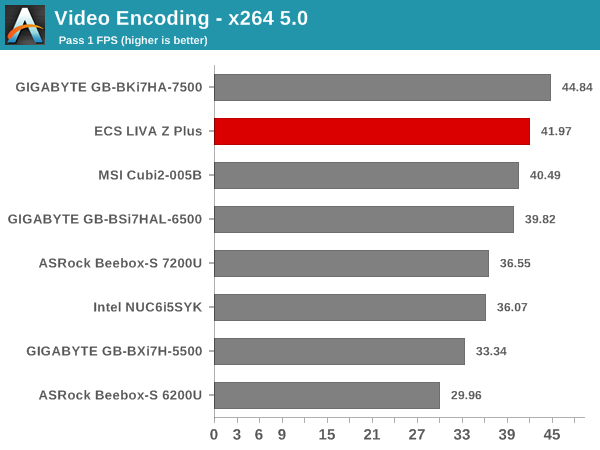
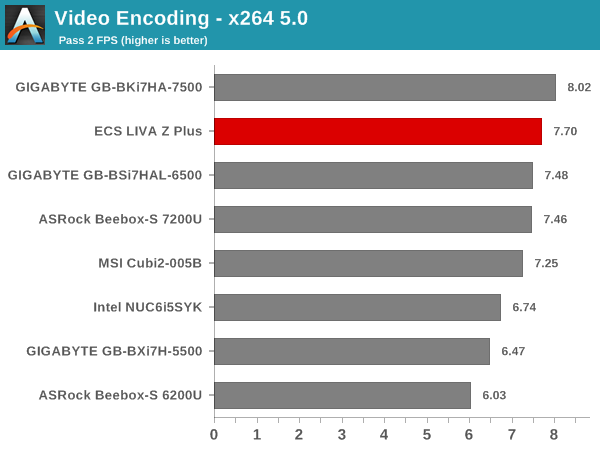
7-Zip
7-Zip is a very effective and efficient compression program, often beating out OpenCL accelerated commercial programs in benchmarks even while using just the CPU power. 7-Zip has a benchmarking program that provides tons of details regarding the underlying CPU's efficiency. In this subsection, we are interested in the compression and decompression MIPS ratings when utilizing all the available threads. The results follow a trend similar to what we observed in the x264 benchmark.
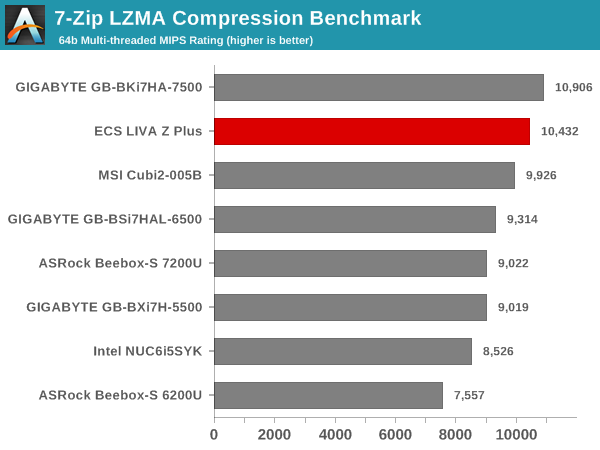

TrueCrypt
As businesses (and even home consumers) become more security conscious, the importance of encryption can't be overstated. CPUs supporting the AES-NI instruction can accelerate the encryption and decryption processes The Core i5-7300U in the ECS LIVA Z Plus does have AES-NI support. TrueCrypt, a popular open-source disk encryption program can take advantage of the AES-NI capabilities. The TrueCrypt internal benchmark provides some interesting cryptography-related numbers. In the graph below, we can get an idea of how fast a TrueCrypt volume would behave in the ECS LIVA Z Plus and how it would compare with other select PCs. This is a purely CPU feature / clock speed based test.
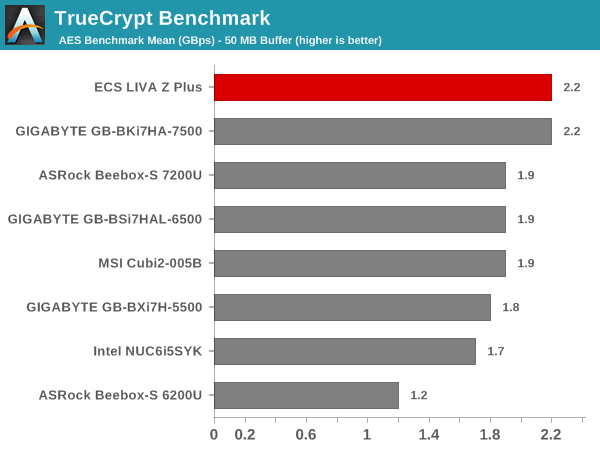
Agisoft Photoscan
Agisoft PhotoScan is a commercial program that converts 2D images into 3D point maps, meshes and textures. The program designers sent us a command line version in order to evaluate the efficiency of various systems that go under our review scanner. The command line version has two benchmark modes, one using the CPU and the other using both the CPU and GPU (via OpenCL). The benchmark takes around 50 photographs and does four stages of computation:
- Stage 1: Align Photographs
- Stage 2: Build Point Cloud (capable of OpenCL acceleration)
- Stage 3: Build Mesh
- Stage 4: Build Textures
We record the time taken for each stage. Since various elements of the software are single threaded, others multithreaded, and some use GPUs, it is interesting to record the effects of CPU generations, speeds, number of cores, DRAM parameters and the GPU using this software. Here, the memory configuration limitations of the LIVA Z Plus catch up, leading to the system coming in the middle of the pack below systems that have CPUs running at lower clock speeds.
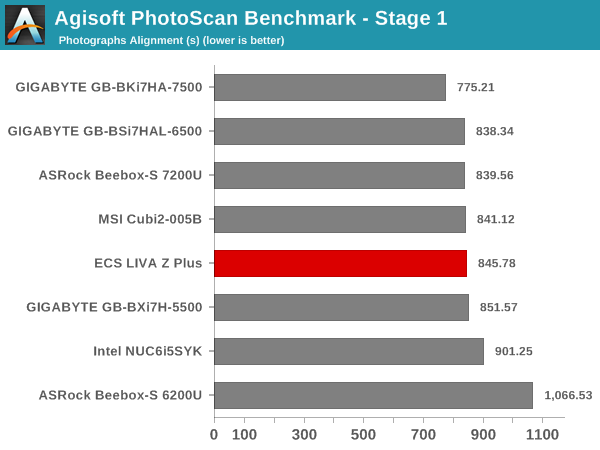

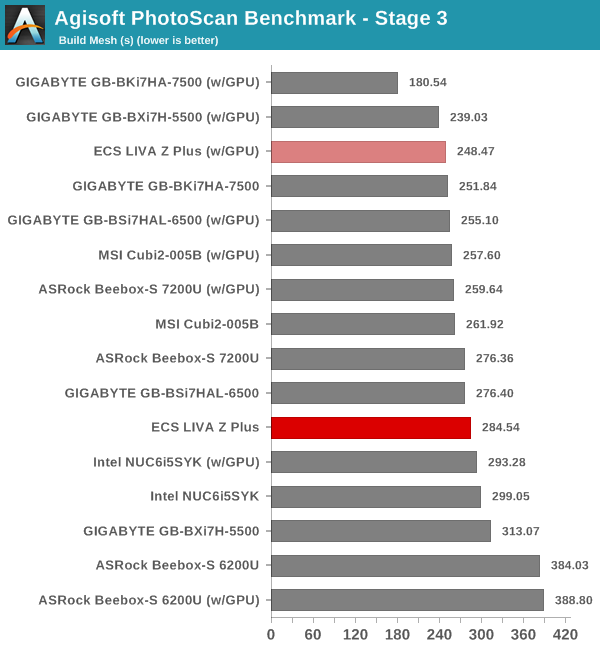
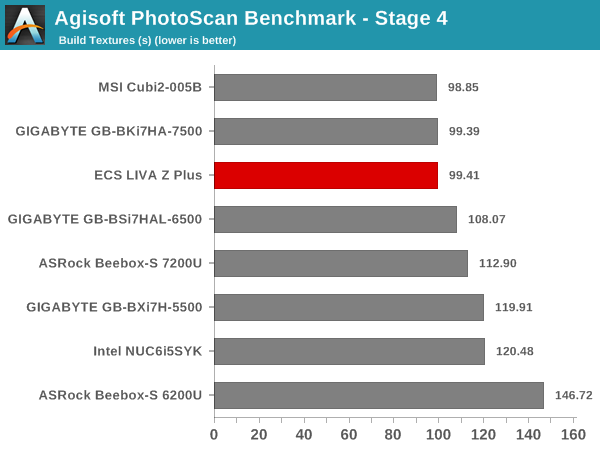
Dolphin Emulator
Wrapping up our application benchmark numbers is the Dolphin Emulator benchmark mode results. This is again a test of the CPU capabilities, and the results are similar to what we observed earlier in this section.











12 Comments
View All Comments
FireSnake - Wednesday, April 12, 2017 - link
Will be interesting once we have Ryzen builds like this :)euler007 - Wednesday, April 12, 2017 - link
What do they have in the 15W TDP range?Cygni - Wednesday, April 12, 2017 - link
Haven't been announced yet, but "M" series Raven Ridge processors are expected to be in the 15W window. Raven Ridge will also have "U" series mainstream mobile APUs (if we assume comperable TDP to Intel designs, perhaps this is 28W), and "H" series high end mobile APUs (perhaps 45W)Shadowmaster625 - Wednesday, April 12, 2017 - link
They now have VESA mount notebook trays for $20. Zip ties cost 5 cents. So why buy this when you can buy a i5 notebook for the same price, and mount it onto the back of your display? That way you get a faster processor, a free backup screen, and best of all, a free UPS.dispo-k - Wednesday, April 12, 2017 - link
Genuine question: why have so many of the reviews posted lately be these USFF barebones kits? I'm not knocking them, but I always thought they were more of a low end desktop for people who preferred the smaller form factor over performance or cost, and obviously for people using them purely for media like a HTPC. Have these systems grown in popularity or are they used in a wider range of applications than I realize?dispo-k - Wednesday, April 12, 2017 - link
Apologies. After reading a number of these lately, I F'd up and didn't read the article before posting. These are apparently popular enterprise solutions, and given that IT admins are likely one of the target demographics for this site, it makes perfect sense that they'd be interested in this type of content. Sorry for not RTFA before posting. I didn't see an option to delete my original post.SquarePeg - Wednesday, April 12, 2017 - link
Nice save! The Technorati would have been on you with gleaming blades and evil intent.fanofanand - Thursday, April 13, 2017 - link
What a strange business decision to go with 1x4 Gb. That has to impact performance, just to save $5-10?Ro_Ja - Friday, April 14, 2017 - link
Basic Tasks and Browsing or Office Work don't need dual channel ram unless you want to play on this thing.Kisper - Saturday, April 15, 2017 - link
There are also some power savings to be had by going with one stick instead of two.